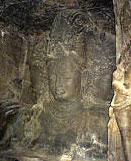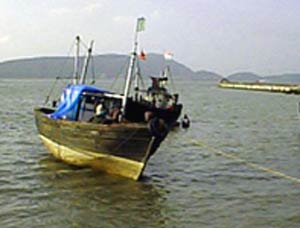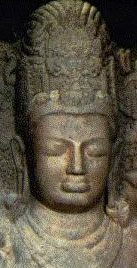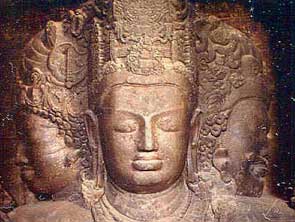| Heritage Elephanta - The Monolithic Majestic Marvel
|
|||||
|
More on Maharashtra • Forts of Maharashtra
Travelogues
Impressions
Heritage | ||||
The island, small and round rises like the back of a giant turtle from amidst the azure depths of the Arabian Sea. A narrow road took us after disembarking to the site of ascent, broken by the persuasive cries of the jamun wallahs selling the salted plum cloured fruit in cleverly designed pouches, holding not more than 7-8 jamuns in each. We first took a steep street up as the caves are located on the top of a hillock shaped island. This was followed by a long flight of sharp stone steps, where the old and the invalid were being carried in palanquins by coolies. Some locals regard the caves as a religious place dedicated to Lord Shiva, which accounts for a large number of aged visitors. The winding staircase was charming and colourful..lined on either side by vendors of semi-precious stones, paperweights, wood carvings etc. The government emporium seemed impressive and reliable and we did buy some artefacts like little elephants encrusted with stones and shells which today, seated royally in my sitting room, bring back fond memories. A map at the museum shows literally dozens of Harappan and late Harappan sites throughout Western Gujarat. But while examining the site at Lothal one should remember that the harbour may today lie about 20 km from the navigable Sabarmati. However, this same harbour, prosperous for many centuries, was where, as recently as 1850, boats could ply to. In fact it's proximity to the sea, the river and hazards of flooding had prompted the Harappan builders of Lothal to create a boundary wall outside the town and to build dwellings on a high platform of sun dried bricks, although precious little of this is intact at the excavation site. Whatever remains allows the imagination to run wild. The caves are named after a big stone statue of an elephant which stood here at the time of Portuguese rule.Today it is decimated to an extent, and stands in the museum of Mumbai. The first impression of the caves is awesome. The sheer size took my breath away, the impact more intense because the brown loftiness of the caves emerges suddenly on the horizon as one rises up the relative subterranean steps. On entering the cavern, it takes some time to adjust the eyes to the dimness here. We see before us a gigantic TRIMURTI or the 3 faced god.
The face to the east with its stern expression is the destroyer and the brow is dominated by the trinetra aspect of the third eye. He is smiling at the cobra in his hand and is adorned with his symbols of human skull, branch of milk bush, twisted snakes in the hair and high up an erect cobra. To the west is a gentle, placid face which is of the preserver and he holds a lotus flower in his hand. The trimurti is the chief attraction in the caves but sculpural richness overflows and is scattered in the adjoining compartments, with their sculptures full of power and life, representing the gods and goddesses of the Hindu pantheon and the stories of their lives. Shiva with his consort Parvati, is a favourite subject. One particularly fascinating one is told to us by an old chowkidaar(caretaker) residing here for the past 35 years. Shiva and Parvati have just had a tiff and the sculpture shows them both seated on Kailash Parbat with Parvati's face turned away from her husband. Our story-teller recounts how Ravana chanced to pass by at that time and being angry at the hill stopping his progress shook the hill. Parvati ran to Shiva for protection and then Ravana was blessed by Shiva for stopping Parvati's fit of anger.
Around the circular caves is a land promenade with fencing which has a life of its own as a modern picnic spot. There are hawkers of colas and softies and little children running after balloons and balls while adults grab some moments of quiet togetherness amidst the panoramic green of the Western Ghats. The rear side of the caves have smaller apartments and are used mainly for private group activities. In one some sadhus were performing a havan while in another, some westerners were practising yoga and meditation. In yet another, a quest for holy spirits was going on to the accompaniment of quaint chants. We descended the steps back to the dock with our minds filled with a sense of strange peace. Time stands still at the Elephanta Caves where believers at one time created songs in stone...the echoes of which whisper enticingly even today in the dim and cool recesses. |
|||||
Editor: Romola Butalia (c) India Travelogue. All rights reserved. |
|||||
 It was a golden Sunday morning in January last that we, a group of 3 office colleagues in Mumbai, set sail from the Gateway of India to the world famous Elephanta Caves. From the hustle and bustle of the contemporary commerce of Mumbai a journey back in time, when faith, mysticism and art reigned supreme, when the challenge of carving out gigantic statues and caves from monoliths was accepted as a blessing, when the tryst with stone gave birth to passionate effigies of Hindu faith, a glorious testimony, even today, of the aesthetics and hard labour of our ancestors.
It was a golden Sunday morning in January last that we, a group of 3 office colleagues in Mumbai, set sail from the Gateway of India to the world famous Elephanta Caves. From the hustle and bustle of the contemporary commerce of Mumbai a journey back in time, when faith, mysticism and art reigned supreme, when the challenge of carving out gigantic statues and caves from monoliths was accepted as a blessing, when the tryst with stone gave birth to passionate effigies of Hindu faith, a glorious testimony, even today, of the aesthetics and hard labour of our ancestors.
 The ferry ride took about 45 mins to the island, the breeze was salty and balmy against our upturned faces. In the background echoed the boisterous shouts of young children excited at the prospect of a funfilled holiday amidst history amidst history and open spaces of greenery, at the Elephanta Island.
The ferry ride took about 45 mins to the island, the breeze was salty and balmy against our upturned faces. In the background echoed the boisterous shouts of young children excited at the prospect of a funfilled holiday amidst history amidst history and open spaces of greenery, at the Elephanta Island. 
 The expression of the first face, facing us is far off-in deep contemplation, and is noble in its calm serenity. In his left hand he holds the citron, an emblem of the womb. The head dress is adorned with a beautifully carved tiara.
The expression of the first face, facing us is far off-in deep contemplation, and is noble in its calm serenity. In his left hand he holds the citron, an emblem of the womb. The head dress is adorned with a beautifully carved tiara.
 There are other carvings too on the walls, representing both the divine as well as the mortal social milieu of those times. The sculptures are chipping at many places and whole pieces of human anatomy are missing in some group scenes. The stone caves are susceptible to water seeping in from above.
There are other carvings too on the walls, representing both the divine as well as the mortal social milieu of those times. The sculptures are chipping at many places and whole pieces of human anatomy are missing in some group scenes. The stone caves are susceptible to water seeping in from above.